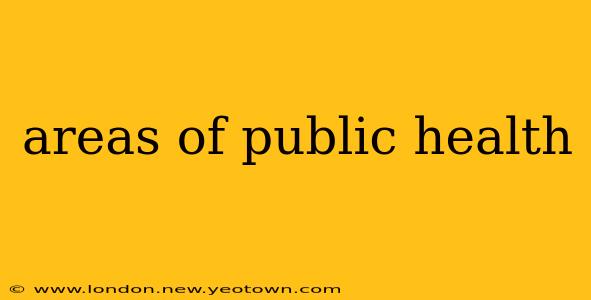Exploring the Vast Landscape of Public Health: A Journey into Well-being
Public health. The term itself evokes images of bustling hospitals and tireless medical professionals. But the reality is far richer and more nuanced. Public health isn't just about treating illness; it's about preventing it, promoting well-being, and ensuring everyone has the opportunity to live a long, healthy life. This journey will explore the diverse and fascinating areas that make up this crucial field.
Imagine a world where preventable diseases thrive unchecked, where clean water is a luxury, and where communities lack access to vital health information. That's a world without robust public health initiatives. Let's delve into the key areas that shape a healthier tomorrow:
What are the main branches of public health?
This is a fundamental question, and the answer isn't a simple list. Public health is a multifaceted field, but we can broadly categorize its core branches:
-
Epidemiology: This is the bedrock of public health. Epidemiologists investigate the patterns, causes, and control of diseases within populations. Think of them as detectives, tracing outbreaks, identifying risk factors, and formulating strategies to prevent future occurrences. Their work is crucial in understanding everything from the spread of influenza to the long-term impact of environmental hazards.
-
Biostatistics: Numbers tell a story, especially in public health. Biostatisticians are the data analysts of the field, using sophisticated statistical methods to interpret complex health data, analyze research findings, and inform public health policies. They're essential for understanding trends, evaluating interventions, and making data-driven decisions.
-
Environmental Health: This area focuses on the impact of our surroundings on our health. Environmental health specialists work to ensure clean air and water, safe food supplies, and the responsible management of hazardous waste. They investigate pollution sources, advocate for environmental protection, and develop strategies to mitigate environmental health risks.
-
Health Policy and Management: The policies and systems that govern healthcare delivery are vital to public health. Professionals in this area work to develop and implement effective health policies, manage health programs, and advocate for healthcare access and equity. They navigate the complex landscape of healthcare funding, regulations, and resource allocation.
-
Health Promotion and Education: Empowering individuals to make healthy choices is paramount. Professionals in this field design and deliver health education programs, develop community-based interventions, and promote healthy lifestyles. They work to increase health literacy, encourage preventative behaviors, and address social determinants of health.
What are some examples of public health programs?
Public health's impact is visible in numerous programs around the globe:
-
Vaccination campaigns: These programs have eradicated or significantly reduced the incidence of diseases like polio and measles, saving countless lives.
-
Clean water initiatives: Access to safe drinking water is fundamental to health. Public health programs work to ensure clean water supplies, preventing waterborne diseases.
-
Health screenings: Regular screenings for conditions like cancer and diabetes can lead to early detection and treatment, improving outcomes.
-
Tobacco control programs: These programs aim to reduce smoking rates through education, policy changes, and cessation programs.
-
Injury prevention programs: These focus on reducing the incidence of injuries through measures like seatbelt laws, bicycle helmet campaigns, and workplace safety regulations.
What is the difference between public health and medicine?
While both fields strive for improved health outcomes, their approaches differ significantly. Medicine focuses on the individual patient, diagnosing and treating illness. Public health focuses on the population, preventing disease and promoting health at a community or national level. A physician treats a patient with pneumonia; a public health official works to prevent pneumonia outbreaks through vaccination campaigns and public health messaging.
How does public health address social determinants of health?
Social determinants of health—factors like poverty, housing, education, and access to resources—significantly impact health outcomes. Public health addresses these determinants through initiatives that promote economic opportunity, improve housing conditions, expand access to education, and strengthen community resources. Understanding and tackling these social factors is crucial for achieving health equity.
The world of public health is a dynamic and ever-evolving field. From the microscopic level of disease investigation to the broad scope of social policy, it's a journey of constant learning, adaptation, and a persistent commitment to improving the health and well-being of populations worldwide. The work is challenging, often unseen, but profoundly impactful—creating a healthier future for all.

